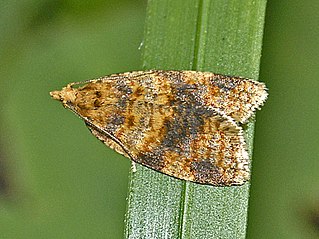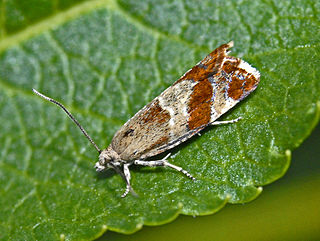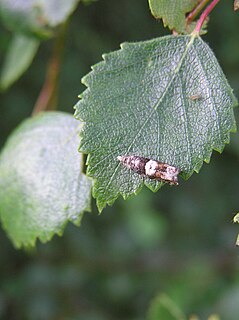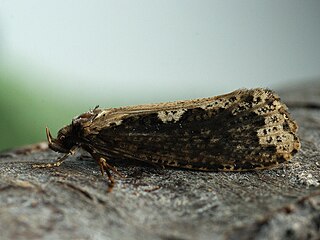
The ingrailed clay is a moth of the family Noctuidae. The species was first described by Johan Christian Fabricius in 1775. It is distributed through most of Europe and the Palearctic.

Epagoge grotiana, common name brown-barred tortrix, is a moth of the family Tortricidae, first described by Johan Christian Fabricius in 1781.

Epinotia solandriana is a moth of the family Tortricidae. It is found in Europe, China, Korea, Japan and Russia.

Agonopterix ocellana is a species of moth of the family Depressariidae. It is found in Europe and was first described by Johan Christian Fabricius in 1775

Graphiphora augur, the double dart or soothsayer, is a moth of the family Noctuidae. The species was first described by Johan Christian Fabricius in 1775. It is found in all of Canada and most of the northern parts of the United States, south in the west to California and New Mexico. It is also found throughout Eurasia, from the British Isles and Scandinavia to Siberia and Japan.

Epinotia is a very large genus of tortrix moths. It belongs to the tribe Eucosmini of subfamily Olethreutinae.

Epinotia cruciana, the willow tortrix, is a moth of the family Tortricidae.

Epinotia demarniana is a moth of the family Tortricidae found in most of Europe, east to the eastern part of the Palearctic realm.

Epinotia nisella is a moth of the family Tortricidae which is found in the Palearctic, Europe and North America. It was first described be Carl Alexander Clerck in 1759.

Epinotia subocellana is a species of moth of the family Tortricidae. It is found in Asia and Europe and was first described by Edward Donovan in 1806.

Epinotia abbreviana is a moth of the family Tortricidae. It is found in Europe and was first described by Johan Christian Fabricius in 1794.

Metendothenia atropunctana is a moth belonging to the family Tortricidae. The species was first described by Johan Wilhelm Zetterstedt in 1839.

Scardia boletella is a moth, belonging to the family Tineidae. The species was first described by Johan Christian Fabricius in 1794.
Epinotia crenana is a moth belonging to the family Tortricidae. The species was first described by Jacob Hübner in 1814–1817.
Epinotia gimmerthaliana is a moth belonging to the family Tortricidae. The species was first described by Friederike Lienig Philipp Christoph Zeller in 1846.
Epinotia granitana is a moth belonging to the family Tortricidae. The species was first described by Gottlieb August Wilhelm Herrich-Schäffer in 1851.














